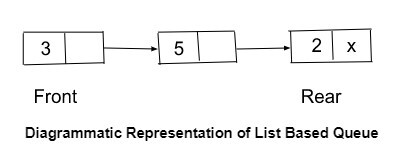
 Data Structure
Data Structure Networking
Networking RDBMS
RDBMS Operating System
Operating System Java
Java MS Excel
MS Excel iOS
iOS HTML
HTML CSS
CSS Android
Android Python
Python C Programming
C Programming C++
C++ C#
C# MongoDB
MongoDB MySQL
MySQL Javascript
Javascript PHP
PHP
- Selected Reading
- UPSC IAS Exams Notes
- Developer's Best Practices
- Questions and Answers
- Effective Resume Writing
- HR Interview Questions
- Computer Glossary
- Who is Who
Difference Between Array-Based Queue and List-Based Queue
Introduction
A queue is a linear data structure that inserts and removes queue elements in a particular order. We can implement a queue in C++ by using arrays and a linked list. Both queue implementations have their benefits and uses. In this tutorial, we will differentiate the array-based Queues and List Based Queues.
What is a Queue?
A Queue is a series of elements that uses the FIFO principle for the insertion and deletion of its elements. A queue in Computer Science resembles the queue of real life where the one who enters first in the queue, will be removed first.
The process of removing Queue data is called deQueue. The operation of adding data into the queue is called enQueue.
The Queue has two points ?
Rear ? Elements in the Queue are inserted from this point.
Front ? Elements from the Queue are removed from this point.
We can implement Queue by using two approaches ?
Array-based Queue
List-based Queue or Linked List Queue
Array-Based Queue
A queue that uses an array for its implementation is known as an Array-based queue. It uses two pointers: Front and Rear, to represent the deletion and insertion points respectively in the Queue.
In this implementation, the array size is predefined before inserting the data. It is the simplest way to insert and delete queue data.

List Based Queue
In a list-based queue or linked list-based queue, a linked list is used for queue implementation. Each queue node comprises two parts: one for storing data, and the other is the link part or memory part.
Each queue element is connected to the memory of the next Queue element. In list based queue there are two pointers ?
Front pointer ? Represent Memory of the last queue element.
Rear pointer ? Represent memory of the first queue element.

Difference Between Array-based Queue and List-Based Queue
S.No |
Array-Based Queue |
Linked List-Based Queue |
|
|---|---|---|---|
1 |
Complexity |
It is easy to implement and carry out operations. |
It is not easy to implement. |
2 |
Searching Process |
It helps in easy and fast searching. |
It is slow and has difficult searching operations. |
3 |
Queue Size |
Define the Queue size at the time of its initialization. |
No need to define the Queue size at the time of queue initialization. |
4 |
Insertion and Deletion Operation |
Difficult data insertion at the beginning and easy insertion at the end of the queue. |
It provides easy data insertion at both Queue ends. |
5 |
Accessing data |
Random data accessing. |
It provides sequential access to the Queue elements. |
6 |
Queue Resizing |
It is difficult to change the queue size. |
It is easy to resize the queue. |
7 |
Memory Usage |
It consumes less memory. |
It consumes more memory. |
8 |
Advantages |
|
|
9 |
Disadvantages |
|
|
Usage of Array-based Queue and List-Based Queue
You can implement a Queue using an array if your queue is of fixed size and no need to alter the queue size. The array-based queue is also useful in case of fast searching with less memory consumption.
Linked list-based queue implementation is useful when queue size is dynamic, and queue elements are inserted and removed multiple times. Although it consumes more memory, it is used for large-scale applications
Conclusion
The use of array-based queues and linked list-based queues depends on the requirement. In large-scale applications array-based queue is unsuccessful, and a Linked list queue is used.
Array-based Queue uses less memory but it wastes lots of memory because after inserting an element at the rear end, some unused memory remains before the first element.

